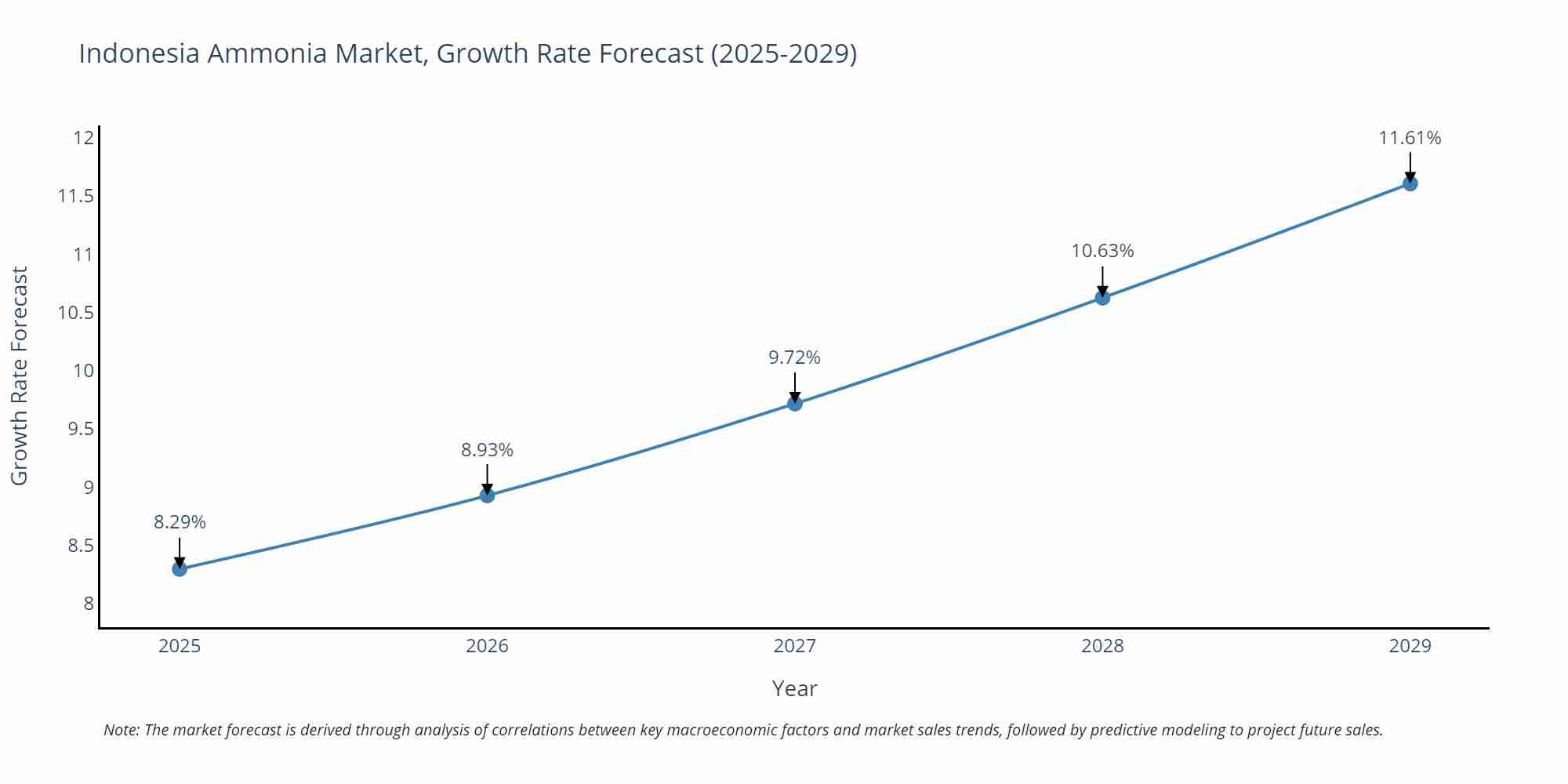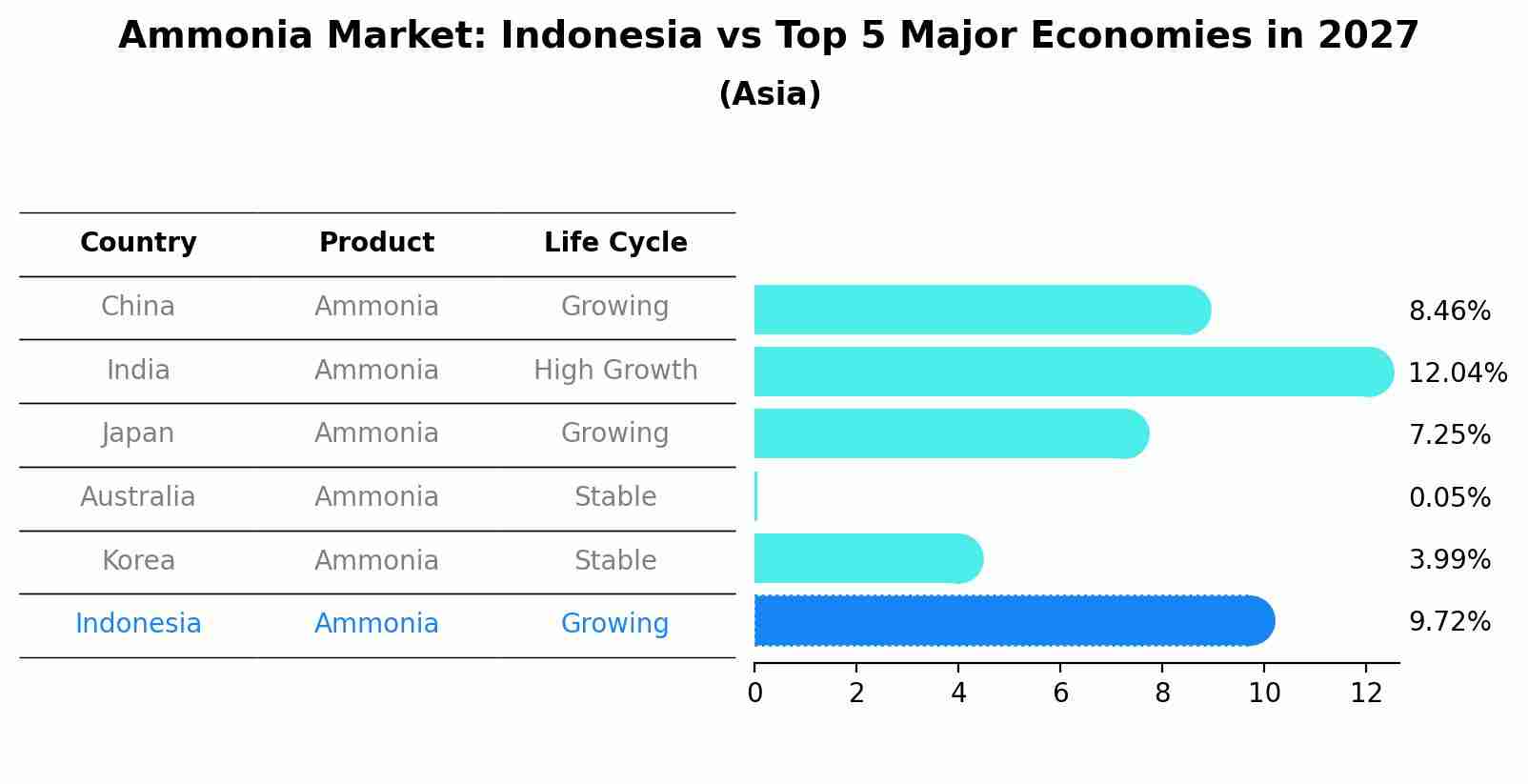Indonesia Ammonia Market (2025-2031) Outlook | Companies, Trends, Growth, Industry, Forecast, Analysis, Share, Size, Revenue & Value
| Product Code: ETC194740 | Publication Date: Jul 2023 | Updated Date: Apr 2025 | Product Type: Market Research Report | |
| Publisher: 6Wresearch | No. of Pages: 60 | No. of Figures: 40 | No. of Tables: 7 | |
Indonesia Ammonia Market Size Growth Rate
The Indonesia Ammonia Market is poised for steady growth rate improvements from 2025 to 2029. The growth rate starts at 8.29% in 2025 and reaches 11.61% by 2029.

Ammonia Market: Indonesia vs Top 5 Major Economies in 2027 (Asia)
Indonesia's Ammonia market is anticipated to experience a growing growth rate of 9.72% by 2027, reflecting trends observed in the largest economy China, followed by India, Japan, Australia and South Korea.

Indonesia Ammonia Market Synopsis
Indonesia is the world?s fifth largest ammonia producer and one of the key exporters in Southeast Asia. The country holds significant reserves of oil, natural gas, coal and other minerals which are used as feedstock for production of ammonia. As per Indonesia Ammonia Marketby6wresearch, the market size reached US$ 1.6 Billion in 2018. It is further expected to grow at a CAGR of 4.1%driven by rising demand from various industries such as fertilizer, food processing and pharmaceuticals.
Market Trends
The Indonesia government has launched several initiatives including tax incentives for investments in energy efficient technologies which have enabled heightened production capacities in recent years. This has resulted in increased availability of ammonia across the country leading to its growing demand among major end users like fertilizer producers who utilize it for producing ammonium nitrate and urea based fertilizers. Furthermore, increasing awareness about environmental pollution coupled with stringent regulations imposed by authorities is further driving up uptake levels amongst industrial consumers which will play a pivotal role in shaping future growth prospects over the coming years.
Market Drivers
Growing agricultural activities along with increasing population has created a huge demand for fertilizers across Indonesia resulting into higher uptake levels amongst farmers as well as commercial buyers alike especially urea based products that require large amounts of ammonia for their production process thereby propelling overall market growth on an upward trajectory over time period under consideration herewith mentioned hereinbefore. Additionally , burgeoning manufacturing activities pertaining to food processing industry also remains another key factor driving adoption rates situated thereinundermentioned hereinwithin this regard aforesaid aforenoted.
COVID-19 Impact on the Market
The impact of COVID-19 on the Indonesia ammonia market has been significant, leading to reduced production and sales due to restrictions in movement and supply chain networks. This has led to a decrease in demand for ammonia from key industries such as fertilizers, plastics, textiles, food processing among others. The government imposed lockdown measures have resulted in decreased economic activities with major fertilizer plants halting their operations while some are operating at lower capacity levels.
Challenges of the Market
High energy costs remain one of the main challenges that continue to affect Indonesia ammonia market adversely impacting prices over time. Additionally, there is also an overcapacity issue which is likely to persist even after the effects of COVID-19 subside because new investments were made before the pandemic hit resulting in excess capacity being available now compared with actual demand figures.Finally, increasing environmental regulations governing emissions have impacted production costs significantly creating additional pressures on profits margins for manufacturers who feel compelled by law to adhere strictly towards these guidelines reducing overall profitability substantially.
Industry Key Players
Some key players operating within the Indonesia ammonia market are PT Pupuk Kujang (PK), PT Pupuk Iskandar Muda (PIM), PT Bimasakti Nusantara Pratama (BNP), Eurochem Antwerpen NV (EA) and PT Kaltim Nitrate Indonesia (KNI). These firms are focused on expanding their capacities by investing heavily into R&D initiatives related with cost optimization technologies which could help them gain an edge against competitors through offering competitively priced products within this region?s ammonia market landscape.
Key Highlights of the Report:
- Indonesia Ammonia Market Outlook
- Market Size of Indonesia Ammonia Market, 2024
- Forecast of Indonesia Ammonia Market, 2031
- Historical Data and Forecast of Indonesia Ammonia Revenues & Volume for the Period 2021-2031
- Indonesia Ammonia Market Trend Evolution
- Indonesia Ammonia Market Drivers and Challenges
- Indonesia Ammonia Price Trends
- Indonesia Ammonia Porter's Five Forces
- Indonesia Ammonia Industry Life Cycle
- Historical Data and Forecast of Indonesia Ammonia Market Revenues & Volume By Type for the Period 2021-2031
- Historical Data and Forecast of Indonesia Ammonia Market Revenues & Volume By Liquid for the Period 2021-2031
- Historical Data and Forecast of Indonesia Ammonia Market Revenues & Volume By Gas for the Period 2021-2031
- Historical Data and Forecast of Indonesia Ammonia Market Revenues & Volume By End-user Industry for the Period 2021-2031
- Historical Data and Forecast of Indonesia Ammonia Market Revenues & Volume By Agriculture for the Period 2021-2031
- Historical Data and Forecast of Indonesia Ammonia Market Revenues & Volume By Textiles for the Period 2021-2031
- Historical Data and Forecast of Indonesia Ammonia Market Revenues & Volume By Mining for the Period 2021-2031
- Historical Data and Forecast of Indonesia Ammonia Market Revenues & Volume By Pharmaceutical for the Period 2021-2031
- Historical Data and Forecast of Indonesia Ammonia Market Revenues & Volume By Refrigeration for the Period 2021-2031
- Historical Data and Forecast of Indonesia Ammonia Market Revenues & Volume By Others for the Period 2021-2031
- Indonesia Ammonia Import Export Trade Statistics
- Market Opportunity Assessment By Type
- Market Opportunity Assessment By End-user Industry
- Indonesia Ammonia Top Companies Market Share
- Indonesia Ammonia Competitive Benchmarking By Technical and Operational Parameters
- Indonesia Ammonia Company Profiles
- Indonesia Ammonia Key Strategic Recommendations
Frequently Asked Questions About the Market Study (FAQs):
1 Executive Summary |
2 Introduction |
2.1 Key Highlights of the Report |
2.2 Report Description |
2.3 Market Scope & Segmentation |
2.4 Research Methodology |
2.5 Assumptions |
3 Indonesia Ammonia Market Overview |
3.1 Indonesia Country Macro Economic Indicators |
3.2 Indonesia Ammonia Market Revenues & Volume, 2021 & 2031F |
3.3 Indonesia Ammonia Market - Industry Life Cycle |
3.4 Indonesia Ammonia Market - Porter's Five Forces |
3.5 Indonesia Ammonia Market Revenues & Volume Share, By Type, 2021 & 2031F |
3.6 Indonesia Ammonia Market Revenues & Volume Share, By End-user Industry, 2021 & 2031F |
4 Indonesia Ammonia Market Dynamics |
4.1 Impact Analysis |
4.2 Market Drivers |
4.3 Market Restraints |
5 Indonesia Ammonia Market Trends |
6 Indonesia Ammonia Market, By Types |
6.1 Indonesia Ammonia Market, By Type |
6.1.1 Overview and Analysis |
6.1.2 Indonesia Ammonia Market Revenues & Volume, By Type, 2021-2031F |
6.1.3 Indonesia Ammonia Market Revenues & Volume, By Liquid, 2021-2031F |
6.1.4 Indonesia Ammonia Market Revenues & Volume, By Gas, 2021-2031F |
6.2 Indonesia Ammonia Market, By End-user Industry |
6.2.1 Overview and Analysis |
6.2.2 Indonesia Ammonia Market Revenues & Volume, By Agriculture, 2021-2031F |
6.2.3 Indonesia Ammonia Market Revenues & Volume, By Textiles, 2021-2031F |
6.2.4 Indonesia Ammonia Market Revenues & Volume, By Mining, 2021-2031F |
6.2.5 Indonesia Ammonia Market Revenues & Volume, By Pharmaceutical, 2021-2031F |
6.2.6 Indonesia Ammonia Market Revenues & Volume, By Refrigeration, 2021-2031F |
6.2.7 Indonesia Ammonia Market Revenues & Volume, By Others, 2021-2031F |
7 Indonesia Ammonia Market Import-Export Trade Statistics |
7.1 Indonesia Ammonia Market Export to Major Countries |
7.2 Indonesia Ammonia Market Imports from Major Countries |
8 Indonesia Ammonia Market Key Performance Indicators |
9 Indonesia Ammonia Market - Opportunity Assessment |
9.1 Indonesia Ammonia Market Opportunity Assessment, By Type, 2021 & 2031F |
9.2 Indonesia Ammonia Market Opportunity Assessment, By End-user Industry, 2021 & 2031F |
10 Indonesia Ammonia Market - Competitive Landscape |
10.1 Indonesia Ammonia Market Revenue Share, By Companies, 2024 |
10.2 Indonesia Ammonia Market Competitive Benchmarking, By Operating and Technical Parameters |
11 Company Profiles |
12 Recommendations |
13 Disclaimer |
- Single User License$ 1,995
- Department License$ 2,400
- Site License$ 3,120
- Global License$ 3,795
Search
Related Reports
- Portugal Occupational Health & Safety Services Market (2025-2031) | Strategy, Consumer Insights, Analysis, Investment Trends, Opportunities, Growth, Size, Share, Industry, Revenue, Segments, Value, Segmentation, Supply, Forecast, Restraints, Outlook, Competition, Drivers, Trends, Demand, Pricing Analysis, Competitive, Strategic Insights, Companies, Challenges
- Netherlands Occupational Health and Safety Services Market (2025-2031) | Strategy, Consumer Insights, Analysis, Investment Trends, Opportunities, Growth, Size, Share, Industry, Revenue, Segments, Value, Segmentation, Supply, Forecast, Restraints, Outlook, Competition, Drivers, Trends, Demand, Pricing Analysis, Competitive, Strategic Insights, Companies, Challenges
- Belgium and Luxembourg Facility Management Market (2025-2031) | Strategy, Consumer Insights, Analysis, Investment Trends, Opportunities, Growth, Size, Share, Industry, Revenue, Segments, Value, Segmentation, Supply, Forecast, Restraints, Outlook, Competition, Drivers, Trends, Demand, Pricing Analysis, Competitive, Strategic Insights, Companies, Challenges
- Russia Women Intimate Apparel Market (2025-2031) | Strategy, Consumer Insights, Analysis, Investment Trends, Opportunities, Growth, Size, Share, Industry, Revenue, Segments, Value, Segmentation, Supply, Forecast, Restraints, Outlook, Competition, Drivers, Trends, Demand, Pricing Analysis, Competitive, Strategic Insights, Companies, Challenges
- Africa Chocolate Market (2025-2031) | Size, Share, Trends, Growth, Revenue, Analysis, Forecast, industry & Outlook
- Global Hydroxychloroquine And Chloroquine Market (2025-2031) | Industry, Trends, Size, Outlook, Growth, Value, Companies, Revenue, Analysis, Share, Forecast
- Saudi Arabia Plant Maintenance Market (2025-2031) | Industry, Size, Growth, Revenue, Value, Companies, Forecast, Analysis, Share & Trends
- Taiwan Electric Truck Market (2025-2031) | Outlook, Industry, Revenue, Size, Forecast, Growth, Analysis, Share, Companies, Value & Trends
- South Korea Electric Bus Market (2025-2031) | Outlook, Industry, Companies, Analysis, Size, Revenue, Value, Forecast, Trends, Growth & Share
- Africa Low Temperature Powder Coating Market (2025-2031) | Companies, Competition, Size, Challenges, Segmentation, Trends, Competitive, Industry, Supply, Strategy, Investment Trends, Growth, Segments, Restraints, Strategic Insights, Revenue, Share, Forecast, Drivers, Analysis, Pricing Analysis, Demand, Consumer Insights, Value, Opportunities, Outlook
Industry Events and Analyst Meet
Our Clients
Whitepaper
- Middle East & Africa Commercial Security Market Click here to view more.
- Middle East & Africa Fire Safety Systems & Equipment Market Click here to view more.
- GCC Drone Market Click here to view more.
- Middle East Lighting Fixture Market Click here to view more.
- GCC Physical & Perimeter Security Market Click here to view more.
6WResearch In News
- Doha a strategic location for EV manufacturing hub: IPA Qatar
- Demand for luxury TVs surging in the GCC, says Samsung
- Empowering Growth: The Thriving Journey of Bangladesh’s Cable Industry
- Demand for luxury TVs surging in the GCC, says Samsung
- Video call with a traditional healer? Once unthinkable, it’s now common in South Africa
- Intelligent Buildings To Smooth GCC’s Path To Net Zero













